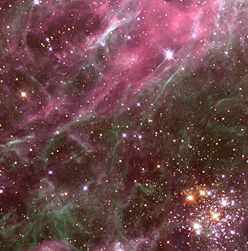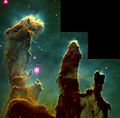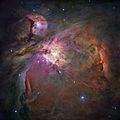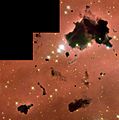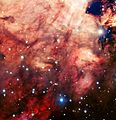H II region facts for kids

An H II region is a region where huge blue stars are formed from hydrogen. They are named after the ionised atomic hydrogen which they produce: H II.
The stars form inside a large cloud of hydrogen gas. The short-lived blue stars formed in these regions give off huge amounts of ultraviolet light. This ionizes the surrounding gas.
H II regions can be several hundred light-years across. The first known H II region was the Orion nebula, which was discovered in 1610. These regions have extremely varied shapes. They often appear clumpy and filamentary, sometimes showing bizarre shapes such as the Horsehead nebula.
H II regions give birth to thousands of stars over several million years. Eventually, this produces a star cluster. In the end, supernova explosions and strong stellar winds from the most massive stars blow away the gases of the H II region. This leaves behind behind a cluster of stars such as the Pleiades.
H II regions can be seen at huge distances in the universe.The study of extragalactic H II regions helps to fix the distance and chemical composition of other galaxies.
Spiral and irregular galaxies have many H II regions, while elliptical galaxies have almost none. In spiral galaxies, like the Milky Way, H II regions are found in the spiral arms, but in the irregular galaxies they are distributed at random.
Some galaxies have huge H II regions, with tens of thousands of stars. Examples include the 30 Doradus region in the Large Magellanic Cloud and NGC 604 in the Triangulum galaxy.
Images for kids
-
Dark star-forming regions within the Eagle Nebula commonly referred to as the Pillars of Creation
-
Messier 17 is an H II region in the constellation Sagittarius.
-
Strings of red H II regions delineate the arms of the Whirlpool Galaxy.
-
An optical image (left) reveals clouds of gas and dust in the Orion Nebula; an infrared image (right) reveals new stars shining within.
-
Trifid Nebula seen at different wavelengths
See also
 In Spanish: Región H II para niños
In Spanish: Región H II para niños


